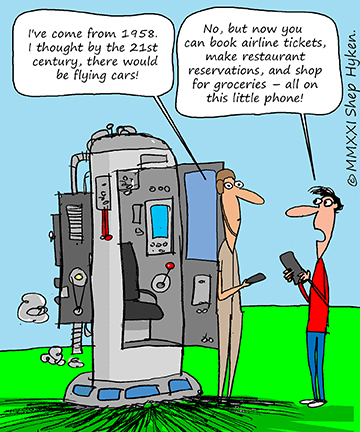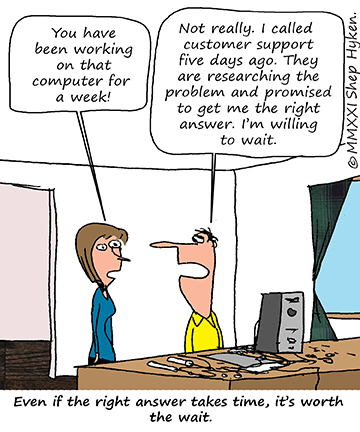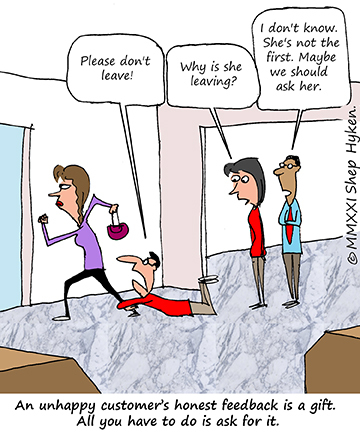Shep Hyken's Blog, page 74
November 19, 2021
Guest Post: How to Level-Up Your Email & SMS CX This Holiday Season
This week we feature an article by Devin Pickell, a Growth Marketer at Privy. He shares his quick tips for keeping your customers informed through email and SMS to level up their buying experience.
The holiday season is fast approaching, and you’re an online merchant expecting a large volume of orders to come through soon. That’s great news! But while you’re fulfilling orders, it’s imperative that you keep your customers in the loop on channels like email and SMS. Below are some of my best quick tips for keeping your customers informed and leveling up their buying experience.
Make the ‘welcome experience’ memorableAfter someone signs up to receive communications from your brand, you should always automate a welcome email to reach their inbox within minutes. Welcome emails are often your first brand touchpoint with a customer away from your website, so the experience needs to be memorable. Below are three tips for making your welcome emails stand out from the rest:
Offer a good discount right away. Free shipping won’t cut it, instead, offer anywhere from 20-30% off their first order. This is how you provide immediate value to your new customer. Send next-level content. Not that blog you’ve sent every new customer the last two years, send an insightful report they’d only get by signing up for email. Appeal to something greater. If your brand has an underdog founder story or makes a real-world impact, you should highlight this in your welcome email.Welcome emails are some of the highest-engagement emails you’ll send to new subscribers this holiday season. Send them with a purpose so you can turn more new subscribers into new customers.
Over-communicate after the purchaseThe post-purchase stage is one of the most important experiences a customer will have when buying from your brand. In fact, order confirmation emails outperform nearly all other marketing emails when it comes to metrics like open rate, click-throughs, viewing time, and revenue.
Your customers entrusted your brand when they clicked ‘confirm order’, now the responsibility lies on you to make this experience as comfortable as possible for them. My tip this holiday season is to over-communicate. Below are five steps for over-communicating with your customers:
Confirm their purchase went through. Tell them when they should expect it. Build hype for them when that date is nearing. Send an email when their item arrives. Send a follow-up email asking them to review their product and rate their experience.Your customers would rather have over communication and peace of mind than under communication and worries.
Get customers comfortable with SMSYou may think you’re spamming customers when sending them texts, but the reality is 91% of consumers said they’re open to receiving text messages from brands they like. If you can get customers to opt-in to receiving SMS, this gives you another channel to reach customers on the device they use most–their phones.
There are different types of SMS marketing, with some of the common including:
Bulk SMS: Use this to send texts to large cohorts of customers. For example, you can send welcome texts in addition to your welcome emails if your customers opted in for SMS. Or you can send customers who spent $500 or more with your business an SMS coupon code. Two-way messaging: A great way to field customer service and support questions is through two-way messaging. Customers can interact directly with someone from your business without having to hop on a phone call. Transactional SMS: These are automated messages that keep your customers in the loop on the status of their purchases, a great tool to add to your post-purchase experience.Brands that have a solid SMS communications cadence will find their customers are more likely to engage with them. It’s the perfect channel to complement your email strategy.
Make sure you’re ready for the holiday seasonInventory is prepped, your website is updated, you have price-drop campaigns ready to go, but what are you doing on the communications side to ensure your customers are informed this holiday season?
You can start by making their welcome experience with your brand better than expected. Send them coupons via email and SMS, tell them a blurb about your brand story, or offer them valuable content upfront.
After they purchase from your brand, make sure they’re in the loop on the status of their orders. Using email and SMS, or a combination of the two is the best way to do this.
Finally, know that your customers aren’t as hesitant about SMS as you may think. As long as you’re SMS compliant and offer your customers the value they expect from the channel, you’ll be able to stand out from the crowd.
Devin Pickell is a Growth Marketer at Privy. He combines his skills in content marketing, SEO, data analysis, and marketing strategy to meet customers at the right moment in their journey.
 For more articles from Shep Hyken and his guest contributors go to customerserviceblog.com.
For more articles from Shep Hyken and his guest contributors go to customerserviceblog.com.
Read Shep’s latest Forbes article: The Great Resignation Leads To Skimpflation
The post Guest Post: How to Level-Up Your Email & SMS CX This Holiday Season appeared first on Shep Hyken.
November 17, 2021
“New-Style” Digital Versus “Old-Fashioned” Human Interactions
 Here’s a question, and I think I know the answer. Would you do business with an airline that didn’t offer the ability to book a ticket online, check-in online, and get your boarding pass online?
Here’s a question, and I think I know the answer. Would you do business with an airline that didn’t offer the ability to book a ticket online, check-in online, and get your boarding pass online?
Assuming that every other airline has these self-service digital options, what if one didn’t? Would you be willing to call for a reservation, wait on hold, pull out your credit card to verbally give your payment information, and stand in line at the ticket counter to check in on the day of departure? Would you choose to fly with this airline over the others?
I feel I can safely say the answer is, “No!”
Assuming everything is comparable among all airlines – the planes are similar, the seats are the same and the pricing is competitive – you would almost certainly not choose to do business with the old-fashioned airline, for one simple reason: The digital experience, at least as it applies to flying, is an easier experience.
It’s simple. Easier wins. Faster wins. More convenient wins. If it means using digital to achieve easier, faster, and more convenient, then customers will use a digital channel. The point is, you can’t fight digital.
More and more customers are looking for digital and self-service options. Our customer experience research finds that 41% of customers prefer digital first and the phone second. That number increases year after year. Customers prefer a self-service solution on the Internet over calling a company, being put on hold, potentially repeating their story, and more. Easy is better, therefore, in many instances, digital is better.
So, back to the original question. The airline that doesn’t make it easy for the customer to do business, and that means using the digital experience, will lose. Metaphorically speaking, you don’t want to be that airline.
If you feel as if you’re lagging in the digital world, what can you do to catch up?If you’re already offering your customers digital solutions, what can you do to make them better? Sit down with the team and consider the following questions:
What digital interactions do we offer that our customers use and appreciate? What digital interactions do our competitors have that we don’t offer? If the competition is doing something different, could we be doing it, too? If so, consider implementing similar digital solutions. Is there a company you love, inside or outside of the industry, that is great at digital interactions? If so, can we implement similar offerings for our customers?These questions will get you moving in the right direction. Most companies already have a digital presence. If a website or app makes life easier and more convenient for your customers, they will want to use it. So, don’t let your competition take your customers away from you, simply because you haven’t kept up.
Shep Hyken is a customer service expert, keynote speaker, and New York Times, bestselling business author. For information on The Customer Focus customer service training programs, go to www.thecustomerfocus.com. Follow on Twitter: @Hyken
customer service training programs, go to www.thecustomerfocus.com. Follow on Twitter: @Hyken
(Copyright © MMXXI, Shep Hyken)
The post “New-Style” Digital Versus “Old-Fashioned” Human Interactions appeared first on Shep Hyken.
November 16, 2021
Amazing Business Radio: Karin Hurt and David Dye
 Courageous Culture
Courageous CultureBringing Great Customer Experience Ideas Forward
Shep Hyken interviews Karin Hurt and David Dye, CEO and President of Let’s Grow Leaders. They are known for practical tools and leadership development programs that stick. Karin and David are the award-winning authors of five books including, Courageous Cultures: How to Build Teams of Micro-Innovators, Problem Solvers, and Customer Advocates. They discuss how leaders can build a culture of sharing ideas, solving problems, and rewarding contributions.






 Top Takeaways:
Top Takeaways:Employees have great ideas on how to improve customer experience and leaders want them. So, why do employees hold back their ideas?
This week’s guests, Karin Hurt and David Dye started an extensive research study with the University of North Colorado Social Research Lab on why employees are holding back these ideas. Here are some quick stats on what they have uncovered from the respondents from the frontlines.
49% of Leaders are not asking for ideas.50% of the responders feel that their ideas will not be taken seriously.40% Lack confidence or they don’t know how to share ideas.Two-thirds feel that their managers are stuck in the way of doing things56% Do not share their ideas because they feel that they would not get credit for the idea.So, how can companies build a “courageous culture”, one that encourages micro-innovators, problem-solvers, and customer advocates within the organization to voice out their ideas? Karin and David developed a 7-step process:
Navigating the narrative. Leaders need to get real with their own relationship with psychological safety and speaking up.Creating clarity. Leaders need to communicate that they really do want ideas and what kinds of ideas are needed.Cultivating curiosity. Managers need to proactively go out and ask for ideas.Respond with regard. Every idea that is shared should get feedback at every level.Practice the Principle. Find out what is truly meaningful about an idea and how it can be scaled and applied in different ways within the organization.Galvanize the genius. Communicate what is important in your new culture five times, in five different ways.Build an infrastructure for courage. Leaders need to make sure that courage is reinforced and not undermined.Quotes:“Leaders need to communicate that they really do want ideas and be clear about what kinds of ideas are needed.
“Leaders and managers need to set the example that it is safe to speak up and contribute ideas.”
“People have ideas. People are thinking innovatively but sometimes, they do not recognize that they have a solution that is going to improve customer experience until they are asked.”
“When employees offer ideas, leaders need to always respond with gratitude and add information when it is necessary whether it will be used immediately or not.”
“You don’t have to be the CEO to create a courageous culture. No matter what role you are in, if you have a great idea to improve customer experience, your leaders want to know about it. Have the courage to bring your ideas forward.”
About:Karin Hurt and David Dye help human-centered leaders resolve workplace ambiguity and chaos so that they can drive innovation, productivity and revenue without burning out employees. As CEO and President of Let’s Grow Leaders, they are known for practical tools and leadership development programs that stick. Karin and David are the award-winning authors of five books including, Courageous Cultures: How to Build Teams of Micro-Innovators, Problem Solvers, and Customer Advocates.
Shep Hyken is a customer service and experience expert, New York Times bestselling author, award-winning keynote speaker, and your host of Amazing Business Radio.
This episode of Amazing Business Radio with Shep Hyken answers the following questions … and more:
What is a Courageous Culture?How does a Courageous Culture impact customer experience?Why don’t employees speak up and advocate on behalf of the customer?What is the 7-step process for building a courageous culture?Does an employee need to be a leader to build a Courageous Culture?The post Amazing Business Radio: Karin Hurt and David Dye appeared first on Shep Hyken.
November 15, 2021
5 Top Customer Service Articles of the Week 11-15-2021
Each week I read many customer service and customer experience articles from various resources. Here are my top five picks from last week. I have added my comment about each article and would like to hear what you think too
Lego Customers Lose Millions of Pieces a Year. The Company’s 4-Word Response Is the Best I’ve Ever Seen by Jason Aten(Inc. Magazine) Lego Group knows something about talking to its customers, and not just because it has a few creative employees. The company has built one of the best examples of a customer service organization I’ve seen. It turns out, as I discovered talking to people at the company, it all revolves around four words.
My Comment: I love great examples of customer service, and this is exactly that. Lego is an internationally recognized brand – and a fun brand. Take a quick read and learn how they handle their customer service issues. You’ll love the four words. It’s a great lesson from an iconic brand. Every company should have its “four words.”
Evaluate Your Customer Service Performance with These 10 Essential Metrics by Julie Weishaar(CustomerThink) One of the most effective ways to stand from your competition in today’s competitive market is to provide stellar customer service. By evaluating relevant key performance indicators (KPIs) or call center metrics, companies can gauge how their customers perceive the support they receive from their organization.
My Comment: I know, metrics aren’t the most exciting topic, but this article is quick and to the point, sharing some important measurements you’ll want to consider. If you’ve struggled with how to measure, or “evaluate” your customer service, here are some ideas to give you some clarity.
Customer Experience Metrics: The Top 5 Ranked by Dan Gingiss(Dan Gingiss) When you have the right metrics, you can sell senior management on your customer experience initiatives and get the buy-in, budget, and resources you need. When you have the wrong metrics, you will often achieve the opposite result. So-called “vanity” metrics, for example – followers, likes, retweets, and influencer mentions in social media, for example – will leave the CEO or CMO exclaiming that famous line from Jerry Maguire: “Show me the money!”
My Comment: And just when you thought you had enough of metrics, my buddy and fellow CX expert, Dan Gingiss, shares his five favorites. We just recently presented a program together on how to get the C-Suite to invest in customer service and CX. This is the way. They want proof in the form of ROI. These metrics will definitely capture their attention. Show them the numbers, and they’ll show you the money!
Ace Hardware Goes Thanksgrilling in Customer Service Strategy by Judy Mottl(Retail Customer Experience) Ace Hardware is going all out in stores this Thanksgiving to help customers not only find the right grill equipment but also chef tips on making the feast a success. It’s all about the brand’s ‘helpful place’ promise to customers.
My Comment: I love Ace Hardware! I even featured them as the role model throughout my book, Amaze Every Customer Every Time. Here is another lesson from an iconic brand, this time one that focuses on customer engagement. Ace Hardware is known as “The Helpful Hardware Place,” and they continue to help and connect with their customers, this time with their “Thanksgrilling” cooking demonstrations that ensure their customers enjoy a magnificent turkey for Thanksgiving.
What Customer Loyalty Looks Like Post Pandemic by Andy Stockwell(MarTech Series) The past eighteen months has seen a significant shift in the way that customer engage and interact with their favourite brands and it’s not just a passing trend. Going forward, marketers need to consider the creation and retention of loyal customers as a fundamental part of business growth.
My Comment: Many experts have claimed that the pandemic destroyed customer loyalty – at least for some customers. Customers learned new ways of doing business. As an example, some customers had seldom, if ever, shopped for groceries online. Now, it’s the only way they shop. If the retailer they were loyal to for years didn’t offer a good delivery option, the customer defected to a competitor. So, what does loyalty look like after the pandemic, and what can you do to keep your loyal customers? You may find some answers in this article.
Shep Hyken[image error] is a customer service expert, professional speaker, and New York Times bestselling business author. Go to The Customer Focus to learn more about our customer service training programs. Follow on Twitter: @Hyken
to learn more about our customer service training programs. Follow on Twitter: @Hyken
The post 5 Top Customer Service Articles of the Week 11-15-2021 appeared first on Shep Hyken.
November 12, 2021
Guest Post: Exceptional Customer Service Doesn’t Start Where You Think
Christan Hiscock is the CEO and co-founder of Kardia Financial Group, an organization that believes that the financial services industry should not be solely focused on dollars, but on helping people truly get to the heart of their financial goals. He shares the foundational guide for everything a company does, the reason why the company was started and its values.
The differences between companies with exceptional customer service and the ones that don’t shine in quite the same way show up long before any interaction with a customer. But so many companies put the majority of their focus into developing a process to find or develop the right skills for the job, and they actually miss the key factors that make a much bigger impact.
Where Customer Service Really StartsThere are two things that should be the foundational guide for everything a company does, and both are at the core of exceptional customer service. The first is the reason the business was initially started. The second is the company’s values. Combined, they create the framework for everything else in the business, especially customer service, because they guide the behavior of each person on the team – but they can only do so when they are clearly defined and communicated consistently.
The reason the company was started to begin with is the problem it solves and the mission that drives the business. Every person on your team needs to know what that is, so they can ensure they deliver the right solution to your clients. A company’s values then guide the way the mission is met and the solution gets delivered. They provide the framework for behavior for everyone on the team and ensure things get done in the right way for the company.
For example, Kardia Financial Group’s values are heart-centered (Kardia means “heart” in Greek), supportive and innovative. In order to be true to that, everything we do must be in full alignment with each one, especially our customer service. For us, that means our team members have to be able to meet people where they are. They must have kindness and curiosity so they can come to understand a client’s specific situation, and from there the ability to provide the support they need to move forward.
When companies lead with their mission and values and use them as the guiding factor for everyone, they create common ground for their teams and their clients, and that sets up a deeper level of connection all around. When a client feels like they connect with a company and it “gets” them, they are far happier and a lot more loyal too, which does wonders for brand advocacy, making it even easier for your customer service team to excel.
The Hidden Segment in Customer ServiceIf you want to develop better loyalty, goodwill, and advocacy in your community, which are indicators of exceptional customer service, start with your people first. All of your people. Loyalty is both an internally and externally driven factor that directly impacts the level of customer service in all ways. Loyalty, and exceptional customer service, can only be developed when you have complete integrity and consistency, and that again comes back to your mission and values and how much every person on your team embodies them, no matter which department they belong to. The clearer your mission and values are, the easier it is for each person on your team to do the right thing and act in the right way.
On top of that, when you are clear about your mission and your values, your team members can also see how they align with them, both personally and professionally. When they can connect their daily efforts with their own values, as well as to the company’s bigger picture, they can be far more certain that they are making a difference in a way that matters to them. As humans, when we know we are making a positive impact, we are happier and we feel more fulfilled. Happier people make a happier workplace, and that’s better for everyone, especially your clients. This is why your entire internal team has just as much impact as your client services team when you want customer service and all-around excellence.
Summing It UpWhen a company leads from every level, with their mission and values as the driving factors for all they do, exceptional customer service must follow. As an added bonus, the increased level of integrity and consistency that flows from that kind of focus will improve internal and external loyalty and advocacy as well. That makes for a greater impact all around.
Christan Hiscock is CEO and co-founder of Kardia Financial Group, which was born from the desire to change the financial services industry through heart-centered services that focus on what’s truly important; the people.
 For more articles from Shep Hyken and his guest contributors go to customerserviceblog.com.
For more articles from Shep Hyken and his guest contributors go to customerserviceblog.com.
Read Shep’s latest Forbes article: The Perfect Customer Letter: Seven Lessons From IKEA
The post Guest Post: Exceptional Customer Service Doesn’t Start Where You Think appeared first on Shep Hyken.
November 10, 2021
A Fast Answer or the Right Answer
 Recently I was talking to a customer support rep. She was amazing. She was personable, genuinely cared, and I felt that she understood my problem. That said, we were struggling to get the problem resolved. She said, “I know you want to get this resolved right away. I can give you a fast answer or I can give you the right answer.”
Recently I was talking to a customer support rep. She was amazing. She was personable, genuinely cared, and I felt that she understood my problem. That said, we were struggling to get the problem resolved. She said, “I know you want to get this resolved right away. I can give you a fast answer or I can give you the right answer.”
Next, she explained why. She said that my problem was complicated, and while she could probably give me the answer that would make me happy in the short term, it was not a long-term solution. She was almost positive I’d be calling again in the future, even more frustrated than I was today. So, when she said that she could give me a fast answer or the right answer, she wasn’t really offering me a choice. She was telling me that I wasn’t going to get my answer that day. But the way she said it, and ultimately the way she handled the problem, was brilliant.
She told me that she wanted to research the problem. She asked if she could call me back the next day so we set up a time to talk, and true to her word, she did – and she was on time. The call was short. It was just an update. She was still researching the issue. Normally I would have been frustrated, but she gave me enough information to make me feel confident she was working on a solution. Once again, she promised she would call back the following day. Good news on that third call. She had the answer and solved the problem. As happy as I was, she seemed even happier.
When you don’t know the answer to a customer’s question or problemI’ve always preached that if you don’t know the answer to a customer’s question or problem, that’s okay. Just know who to go to or where to go to get the answer. Be honest about it. Customers want the truth, even if it’s not what they want to hear. And, if you have to make them wait, tell them how long it will be. Then don’t be late! Customers don’t mind waiting if they are informed, know what the next step is, and things continue to move in the right direction. That builds confidence.
Customer loyalty requires creating confidence, not perfection. Obviously, I would have loved the problem to be resolved on the first call, but every step of the way my rep made me feel confident we were heading in the direction of a resolution. That confidence makes me want to continue to do business with the company. By the way, here’s a reminder of my loyalty formula:
Great Customer Service + Confidence = Potential Customer Loyalty
Shep Hyken is a customer service expert, keynote speaker, and New York Times, bestselling business author. For information on The Customer Focus customer service training programs, go to www.thecustomerfocus.com. Follow on Twitter: @Hyken
customer service training programs, go to www.thecustomerfocus.com. Follow on Twitter: @Hyken
(Copyright © MMXXI, Shep Hyken)
The post A Fast Answer or the Right Answer appeared first on Shep Hyken.
November 9, 2021
Amazing Business Radio: Simon Mainwaring
 Leading With We
Leading With We How Businesses Can Lean into Their Purpose
Shep Hyken interviews Simon Mainwaring, Founder & CEO of We First, a strategic consultancy accelerating growth and impact for purpose-driven brands. He is the author of Lead with We: The Business Revolution That Will Save Our Future. They discuss why companies should take part in creating solutions to the significant issues that the world is facing today.






 Top Takeaways:
Top Takeaways:Customers and employees know that customer experience is more than enjoying your product and feeling like they are valued in the way that they are taken care of. It is also in how they feel about your company and what you are doing in the world.
Is your company part of the problem or part of the solution?
We are facing social, economic, and environmental issues. For the past two years, we have been going through a global health crisis. Your customers and employees are looking at you. They want to see where you stand on these issues and if it aligns with theirs.
Why should you care? And, what’s in it for your business?
The short answer is that people want to buy from, invest in, and work for companies that are doing good.
There’s a new expectation, not just from customers, but also for employees. How you treat your employees, how they can relate, identify, and invest themselves in your purpose will determine your ability to attract the talent you need and to get the most out of them, even during difficult times.
The more you lean into your purpose and share it with your employees, the more engaged they’ll be. As a result, you’ll retain them longer, they will be more productive, and they’ll be more effective advocates for your brand.
Quotes:“Employees are the most effective advocates for your brand, your products, and how you’re showing up in the world.”
“The culture you build inside your company can either work for you or against you.”
“Your reputation is equally important as the products that you are selling.”
“We want to feel good about what we do on a daily basis. We want to show up in the world that makes us feel like our time has meaning, has significance, and we are not making things worst.”
About:Simon Mainwaring is the founder & CEO of We First, a strategic consultancy accelerating growth and impact for purpose-driven brands. He is the author of Lead with We: The Business Revolution That Will Save Our Future and the host of the Lead With We podcast.
Shep Hyken is a customer service and experience expert, New York Times bestselling author, award-winning keynote speaker, and your host of Amazing Business Radio.
This episode of Amazing Business Radio with Shep Hyken answers the following questions … and more:
What is the “Lead with We” movement?How can brands communicate their stance on How brands are taking a stand on social issues?What is conscious capitalism?How can employees take part in the “Lead with We” movement?What is good company culture?The post Amazing Business Radio: Simon Mainwaring appeared first on Shep Hyken.
November 8, 2021
5 Top Customer Service Articles of the Week 11-8-2021
Each week I read many customer service and customer experience articles from various resources. Here are my top five picks from last week. I have added my comment about each article and would like to hear what you think too.
The Great CX Debate: Should Customer Experiences Be Effortless or Exceptional? by Jon Picoult(destinationCRM) In a provocative Harvard Business Review article, researchers from the Corporate Executive Board (CEB) argued in 2010 that companies should Stop Trying to Delight Your Customers, because “wowing” customers was a losing strategy. The key to building customer loyalty, they claimed, was to simply make it effortless for people to do business with you.
My Comment: This article opens with a reference to a Harvard Business Review article titled Stop Trying to Delight Your Customers. Who wouldn’t like to delight customers!? The key is defining “delight.” It’s 11 years later, and the debate continues. Sure, you want to create an experience that is memorable and gets the customer to come back. This article has a few ideas and a perspective from the author of From Impressed to Obsessed: 12 Principles for Turning Customers and Employees into Lifelong Fans. By the way, who wouldn’t like to turn their customers into lifelong fans!?
100 Totally Wacky & Weird Questions People Ask Retailers That Catch Them Off Guard—And Probably Make You Giggle, Too! by Bob Phibbs(Bob Phibbs The Retail Doctor) While much has been made of the Great Resignation in retail, hospitality, and other service jobs – and it is serious – retail frontline workers often get some of the oddest and funniest requests. Here are 100 of the strangest things retailers have been asked by customers.
My Comment: Time for a little humor. While the focus is on the “wacky and weird” questions people ask retailers, I bet if you talked to your employees on the front line, they would have similar types of questions. People ask some crazy questions. Here’s one of the many that made me smile. Can you give me a discount on this hat as I’m going to wear it very rarely?
4 Customer Experience Strategies Inspired By Vincent Van Gogh by Chip Bell(Forbes) Pretend your organization has an okay, not great, customer experience. You rarely get customer complaints, but you never get accolades either. Impressed by the genius of Van Gogh, pretend you could hire him as your customer experience consultant. What would Van Gogh recommend? Here are his poignant words as powerful principles reflecting his probable perspective.
My Comment: It’s time for a little culture mixed in with some customer experience education, and these lessons come from the master painter, Vincent Van Gogh. Chip Bell, author and a customer experience expert, has taken Van Gogh’s life story and found four valuable lessons that we can all use in our CX strategy. The four lessons come under the topics of innovation, managing detail, creating memorable experiences, and creating a unique sensory experience.
7 Best Practices to Handle (and Ace) Customer Interactions by Aayushi Sanghavi(G2) Effective customer conversations help meet customer expectations while building trust and loyalty toward your brand and products. While there are several ways to improve your customer interaction practices, it’s important to remember that communication is an ongoing process and requires consistent time and effort.
My Comment: A customer interaction, as defined by the author, is “any communication between a business and its customers.” And, even though the title reads “Seven Best Practices to Handle Customer Interactions,” there is much more than just that. You’ll learn about the five stages of a customer interaction cycle, seven types of customer interactions, how to build a customer interaction strategy, and much more. This is an excellent article that deserves your attention.
5 Ways to Improve Customer Experience as Online Competition Heats Up by Steve Olenski(CMSWire) Improving customer satisfaction and experience with your brand and online store is only possible when you find out how the target customers interact online, what product they like, what pages they visit when they come to your site and more. Customer feedback can also help you know exactly what you should do to improve your brand and conversion rate. Here are some tips to improve the digital customer experience for your target audience.
My Comment: We close out this week’s Top Five list with an article about online CX. More and more, businesses are going online to sell their products and services. Creating the right online experience is more important than ever. As more businesses move online, you must capture your audiences’ (customers’) attention and deliver an experience that gets them to say, “I’ll be back!” Here are five ways that can help make that happen.
Shep Hyken[image error] is a customer service expert, professional speaker, and New York Times bestselling business author. Go to The Customer Focus to learn more about our customer service training programs. Follow on Twitter: @Hyken
to learn more about our customer service training programs. Follow on Twitter: @Hyken
The post 5 Top Customer Service Articles of the Week 11-8-2021 appeared first on Shep Hyken.
November 5, 2021
Guest Post: Are Customer Surveys the Best Way to Receive Feedback About Your Brand?
Jacob Borgeson is the Product Marketing Director at Khoros where he helps brands understand how communities can help their businesses. He shares the challenges and limitations of using surveys to gather feedback about customer experience.
Surveys will always be a critical component of a brand’s customer engagement strategy. Not only are they essential for businesses to improve, but they provide an outlet for customers to share meaningful brand feedback.
Customers are often more than happy to provide brand feedback, as data suggests 81% of people are willing to participate in a survey regarding a recent customer service interaction. However, surveys are not the end all be all of improving your customer experience. While surveys can provide insight into the customer sentiment, it’s vital to understand their capabilities and limitations.
Surveys don’t tell the whole storyMost customers want to provide feedback to your brand, as 64% of consumers appreciate when a brand seeks out their feedback or opinion in a survey.
Surveys give consumers the opportunity to voice their opinions and to interact with the brand. Research shows that customer intent, when completing a survey, is usually either extremely positive or extremely negative. These types of results often paint a skewed picture of your brand, with results on both ends of the spectrum providing little insight of actionable areas for improvement.
While brands can and should utilize surveys, it shouldn’t be the only way you obtain feedback. In fact, many companies are unaware of the plethora of unsolicited feedback that exists in more organic channels. Your customers are talking to you about your brand, and now is the time to listen.
Consumers are willing to give brands feedback, the challenge is finding the right way to gather these insights so all customer experiences can be shared and heard.
Is the feedback really real?While surveys provide valuable feedback, there may be better ways to obtain customer feedback. A few issues with surveys include low response rates, skewed results, and incomplete data.
Response rates for surveys tend to be low, as Customer Thermometer notes that only 5-30% of customers will fill out the survey. Receiving feedback from one-third or less of your customers does not provide you a statistically significant amount of data to base decisions on — especially when the people sufficiently motivated to complete a survey are either the happiest or most upset few!
The next challenge comes as a consequence of trying to inflate the response rate — bias.One of the most popular ways to address low response rates is by offering compensation to complete a survey, but this can result in consumers providing low-quality feedback. In a survey by Khoros, 23% of participants admitted they sometimes take feedback surveys to get a reward, but don’t provide honest feedback. Survey results could also be skewed by employees, who may encourage customers to give positive feedback. In fact, the same survey above found that 37% of customers are hesitant to provide negative feedback if they think it will affect an employee’s job. Negative results are particularly important in highlighting areas in need of improvement. In many executives’ minds, the negative feedback is what they need to understand business problems and fix them! All this must be considered when determining the best method to gather CX data.
Finally, surveys can also be challenging to analyze because they may have incomplete data. In some cases, brands may receive partially completed surveys that provide limited information. Furthermore, a lot of surveys typically only ask about a single interaction with a brand because consumers are more likely to respond to short surveys. However, getting feedback about a single interaction doesn’t give a full perspective about the customer experience as a whole.
A majority (76%) of consumers think a brand should care about their overall experience. If you are not collecting data about your overall customer experience, you are missing out on opportunities to improve. If you cannot get reliable data from your surveys, it may be time to look at different avenues.
Unsolicited feedback is the key to successWhile surveys will always be a vital component of a brand’s CX strategy, it’s crucial to accompany these efforts with unsolicited, unfiltered feedback to encapsulate the full customer experience. Luckily, your customers are already providing this feedback through alternative channels.
Feedback in the form of online reviews, social media interactions, community forums, support interactions via chat, email, or phone, and other methods is more likely to reflect genuine opinions and opportunities for customer service improvements. Capturing this feedback can help your brand evaluate what areas you’re doing well in, and where you can improve as well.
Furthermore, brands can see how other users respond to this feedback to see how the conversation changes in real-time, and they may be able to get ahead of issues before they have a chance to progress.
Improve customer experience by understanding the whole pictureGathering customer feedback is essential to tweak and improve your brand’s CX strategy and provide the best experience possible. Surveys are a tried and true method for gathering feedback, but the results of this solicited feedback come with some challenges and limitations. To address the areas where surveys fall short, brands must utilize alternative methods to capture customer opinions. Getting feedback through your everyday customer interactions in support, online reviews, social media, and community forums will help fine-tune your brand’s customer experience and unlock long-term brand loyalty. It’s not easy, but the value you uncover, and the speed with which you gather these insights will help you compete and win in our more dynamic, digital-first world.
 For more articles from Shep Hyken and his guest contributors go to customerserviceblog.com.
For more articles from Shep Hyken and his guest contributors go to customerserviceblog.com.
Read Shep’s latest Forbes article: Forrester Research Uncovers Big Changes In Customer Experience For 2022
The post Guest Post: Are Customer Surveys the Best Way to Receive Feedback About Your Brand? appeared first on Shep Hyken.
November 3, 2021
When Your Customer Experience Hits a “Bump in the Road”
 One of our faithful subscribers sent in a question. While he’s in the hospitality industry, this could apply to any type of business. There have most likely been times that many of us have fallen short in taking care of our customers. It could be an isolated incident, which is easy to fix. But what happens when it becomes a trend? With that in mind, here’s his question, followed by my answer and comments. He writes:
One of our faithful subscribers sent in a question. While he’s in the hospitality industry, this could apply to any type of business. There have most likely been times that many of us have fallen short in taking care of our customers. It could be an isolated incident, which is easy to fix. But what happens when it becomes a trend? With that in mind, here’s his question, followed by my answer and comments. He writes:
I would love to get some service-related feedback. My hotels have struggled this year with our service scores. In years past both of my locations were consistently in the top 30% of brands. This year we have been in the bottom 30%. Any advice/ideas to get our scores moving in a positive direction would be greatly appreciated. Thank you in advance.
My answer to him was as follows:
This is a big question that could have many answers. There are lots of variables. Consider these five questions:
Do you have the same number of employees, or did you cut employees because of the pandemic? Is there a common complaint you’re hearing over and over? Is there one person (or more) that you know is causing the problem? Do you consistently train and have daily or weekly huddles where you discuss the service opportunities that were missed in the last day (or week)? Do you provide ongoing reinforcement or training to keep your employees guest-focused? You don’t need to answer me. These questions are for you and your management team. Hope they are helpful.I think you’ll agree that you don’t have to be in the hotel or hospitality industry to benefit from answering these questions. Other than the first question, which mentions the pandemic, these questions could be appropriate any time you notice a slip in your ratings and/or reviews. There are many reasons that ratings could drop. It could be a downturn in the economy. It could be supplier issues. It could be a hiring problem. It could be that a competitor is delivering a better experience. The list could go on and on.
As we wrap up here, there is something important to point out. This hotel owner knew his ratings were slipping and wanted to do something about it. So, consider these three steps. First, there must be a way to measure the experience. Second, beyond the feedback, listen to what customers and employees are saying, which gives your measurement some context. And third, once you have data and feedback, do something about it. Breaking that down into three words: measure, interpret, and act. That’s a valuable formula for any type of business.
Shep Hyken is a customer service expert, keynote speaker, and New York Times, bestselling business author. For information on The Customer Focus customer service training programs, go to www.thecustomerfocus.com. Follow on Twitter: @Hyken
customer service training programs, go to www.thecustomerfocus.com. Follow on Twitter: @Hyken
(Copyright © MMXXI, Shep Hyken)
The post When Your Customer Experience Hits a “Bump in the Road” appeared first on Shep Hyken.



